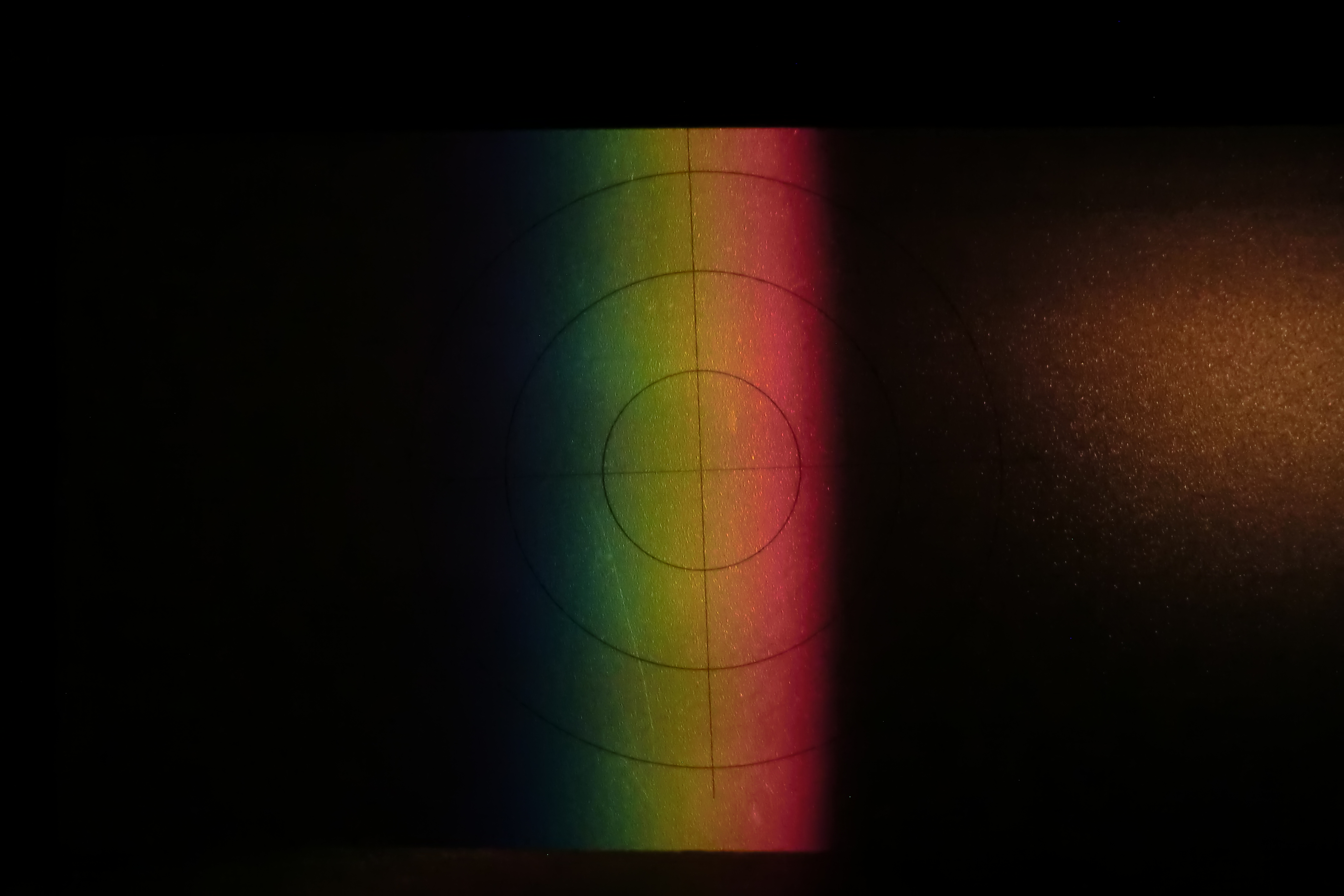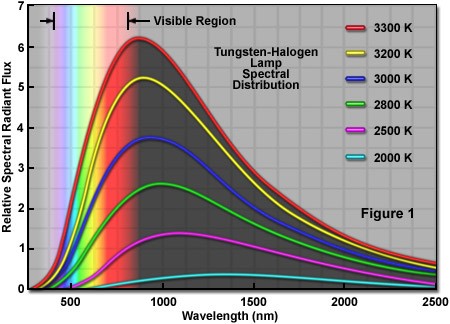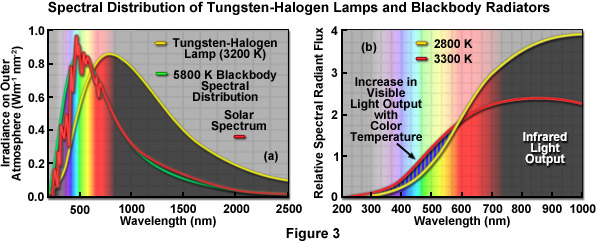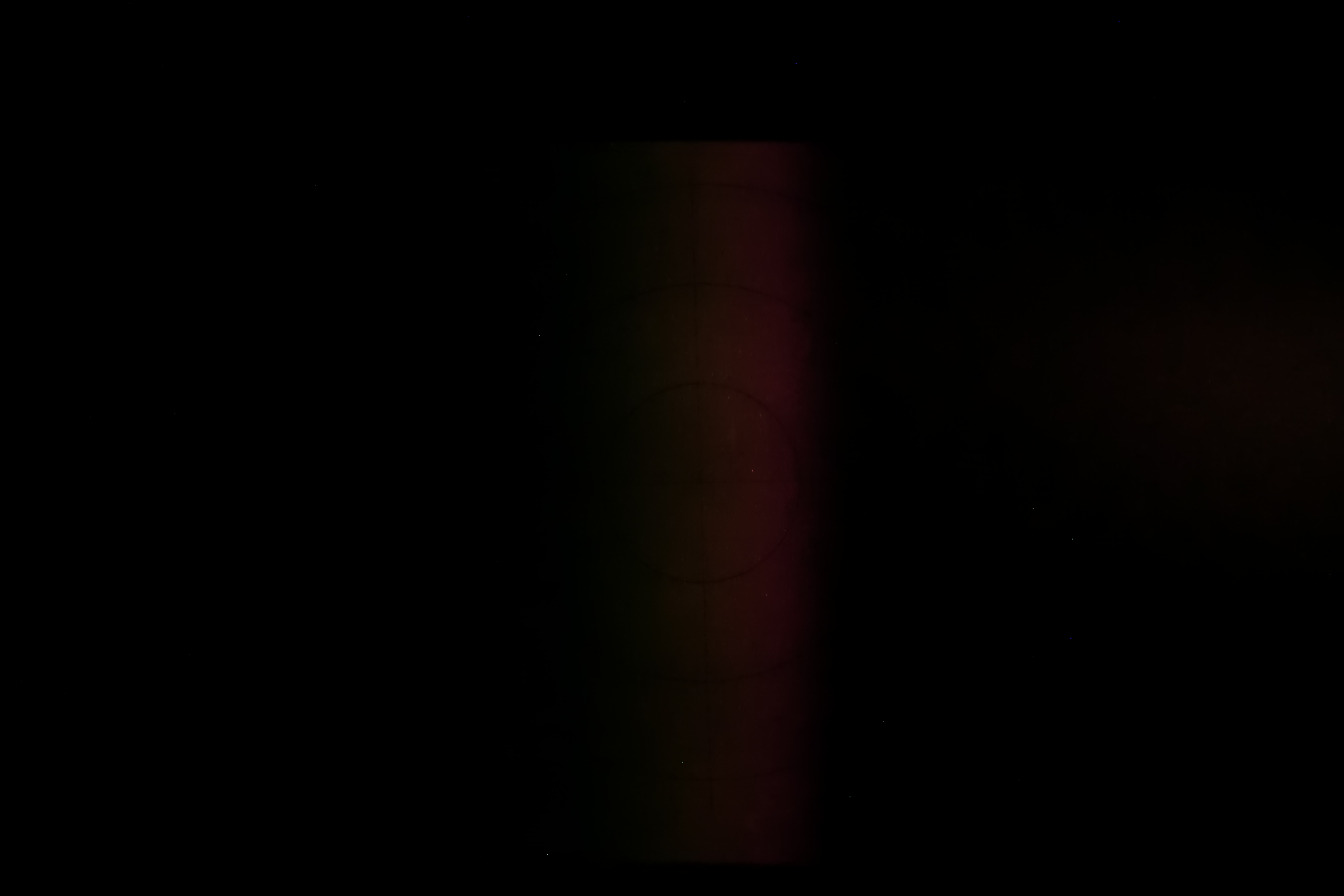Created: 26 December 2014
Published: 26 December 2014
Last updated: 07 December 2015
This page contains two tests:
– Glass Prism
– Diffraction foil
Test goal:
This test is to check whether a brigther/dimmer incandescent lamp will have:
- only a brighter/dimmer diffraction pattern
- any other differences to the diffraction pattern.
Theory:
With different powers an incandescent lamp operates at different temperatures of the glow-wire.
The law of Stefan-Bolzmann states that the total energy radiated per unit surface area of a black body across all wavelengths per unit time (also known as the black-body radiant exitance or emissive power),  , is directly proportional to the fourth power of the black body’s thermodynamic temperature T:
, is directly proportional to the fourth power of the black body’s thermodynamic temperature T:

So different power, different glow-wire temperature, different amount of radiation.
At the website of Zeiss the following picture is shown:
Above 2800K all frequencies must be visible. A normal lamp operates around 2700K at 240V. Thus the colors red and yellow are of interest. Because diffraction theory is based on frequency/wavelength the width of the color bands in the rainbow should not change.
Also from Zeiss the following picture which shows a different shape of the curve at different temperatures when normalized to the same flux.
This picture is already a sign that different types of ‘isotope’-photons are generated at the same frequency. Remember: 1 nm difference in ‘wavelength’ is 700THz difference in frequency!!
The question here is:
- Does brighter/more radiation means brighter not wider. (more of ’the same photons’ per frequency)?
- Does brighter/more radiation also mean brighter and wider (‘other additional photons’ per frequency)?
When the latter is true one would expect to get certain changes in refraction angles/patterns.
Test description 28 december 2014; Glass Prism:
- The light source is a normal 50 watt halogen lamp. To get less light in the surroundings it has been mounted in a 10 liter metal coffee bin. In the bin a 6 mm hole has been drilled.
- The power source is a transformer. Capable of settings between 0 ..300V. The two power settings are 240V and 160V. At 240V the transformer states 0.6 A. Thus the power would be 144W. Remember this is DC power.
- The prism is a normal triangular glass prism. Brand and composition unknown. It has been placed in front of the 6 mm hole in the bin. The refraction pattern has been search by hand. Angle of side of the prism to the incoming light beam unknown. For reference inside the refraction pattern an piece of plastic sheet with a cross scale has been placed.
- The detector is a 14.4 mega pixels casio exilim EX-H15 camera. The pictures are taken with normal/night scene setting.
The results:
Despite all the unknowns in the test set up, this test is to search for differences. The composition of the prism is unknown but the same for all pictures. All that will be changed is the volts/power.

240V
The discussion:
My detector cannot be set to longer exposure times than 4 seconds. So the results are not clear yet. Maybe at lower intensity it takes longer than 4 seconds to build up a clear picture.
What can be seen is the smaller band of color at 160 V. This can be due to the reduced power/reduced intensity (cannot be exactly measured).
But why do we keep seeing the center colors and not the colors at both ends of the spectrum?
- The sensitivity of our eyes is known to be not the same for every color in the visible spectrum.
- Maybe the camera has the same sensitivity scheme as our eyes?
The wider band at 240 V does seem to contain wider sub-bands but this can also be due to eye/camera sensitivity.
Conclusion 28 december 2014; Glass Prism:
With this ’test’ no changes to the refraction pattern can be seen. Let’s make a better test.
Test description 20 March 2015; Diffraction Foil:
- The light source is a normal 25 watt incandescent lamp.
- The power source is a transformer. Capable of settings between 0 ..300V. Remember this is DC power.
- The diffraction foil is acquired from Edmundoptics.
- The detector is a 14.4 mega pixels casio exilim EX-H15 camera.
The results:
The results of the first order between 250V and off:
The discussion:
Nice movie. It seems that the color yellow and blue get more brighter than the other colors. The band does get smaller/wider. It can be clearly seen in the movie.
But we cannot forget the threshold of the camera. Neither the limitations of our eyes. The camera sees more radiation than our eyes. But strangely the definition of my eyes is more clear. I see a sharp image behind the foil at the depth of the lamp. The camera does see the image at the foil.
Next attempt to manually focus the camera at the location behind the foil



